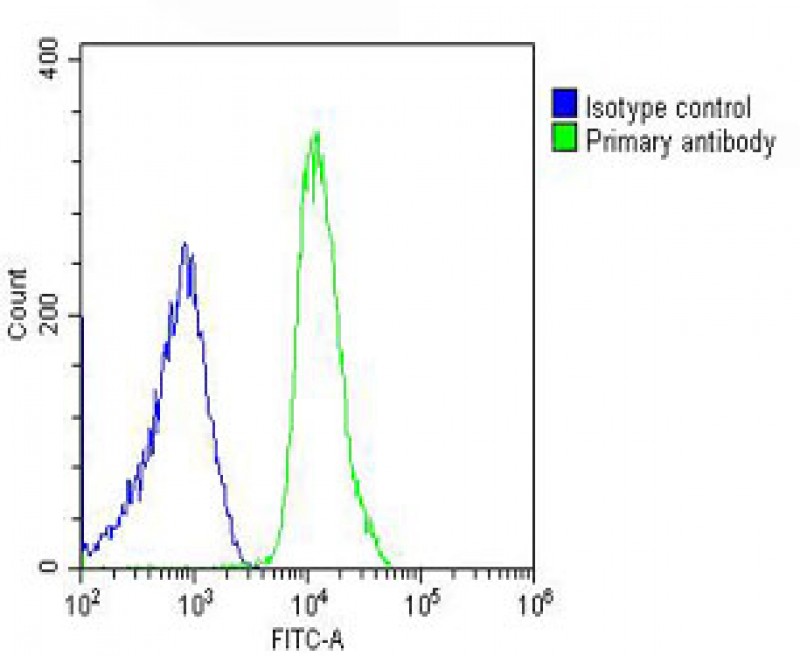

| WB | 1/2000 | Human,Mouse,Rat |
| IF | 咨询技术 | Human,Mouse,Rat |
| IHC | 咨询技术 | Human,Mouse,Rat |
| ICC | 技术咨询 | Human,Mouse,Rat |
| FCM | 1/25 | Human,Mouse,Rat |
| Elisa | 咨询技术 | Human,Mouse,Rat |
| Aliases | SH3 and PX domain-containing protein 2B, Adapter protein HOFI, Factor for adipocyte differentiation 49, Tyrosine kinase substrate with four SH3 domains, SH3PXD2B, FAD49, KIAA1295, TKS4 |
| Entrez GeneID | 285590 |
| WB Predicted band size | 101.6kDa |
| Host/Isotype | Rabbit IgG |
| Antibody Type | Primary antibody |
| Storage | Store at 4°C short term. Aliquot and store at -20°C long term. Avoid freeze/thaw cycles. |
| Species Reactivity | Human |
| Immunogen | This SH3PXD2B antibody is generated from a rabbit immunized with a KLH conjugated synthetic peptide between 596-628 amino acids from human SH3PXD2B. |
+ +
以下是关于SH3PXD2B(TKS5)抗体的3篇代表性文献的简要总结:
---
1. **文献名称**:*"The invadopodia scaffold protein TKS5 is required for the growth of human breast cancer cells in vitro and in vivo"*
**作者**:Blouw B et al. (2008)
**摘要**:研究发现SH3PXD2B(TKS5)在乳腺癌细胞侵袭性伪足(invadopodia)形成中起关键作用,通过抗体定位证实其富集于侵袭性结构,敲低TKS5显著抑制肿瘤生长和转移。
2. **文献名称**:*"TKS5 and SH3PXD2B mediate VEGF-induced endothelial cell migration and tube formation"*
**作者**:Strickland LA et al. (2006)
**摘要**:利用SH3PXD2B抗体检测其在血管内皮细胞中的表达,揭示其通过调控细胞骨架重塑促进血管生成,为抗血管治疗提供潜在靶点。
3. **文献名称**:*"SH3PXD2B mutations expand the phenotypic spectrum of Frank-Ter Haar syndrome"*
**作者**:Chou CM et al. (2016)
**摘要**:通过免疫印迹(Western blot)和免疫荧光验证SH3PXD2B基因突变患者的蛋白表达缺失,表明其与Frank-Ter Haar综合征的骨骼和心脏发育异常相关。
---
**备注**:上述文献可通过PubMed或Google Scholar搜索标题获取全文。若需实验细节(如抗体货号、应用场景),建议进一步查阅抗体供应商(如Abcam、CST)的技术说明。
The SH3PXD2B antibody is a research tool designed to detect the SH3PXD2B protein, encoded by the SH3PXD2B gene (Src homology 3 and PX domain-containing 2B). This protein, also known as TKS4 (Tyrosine Kinase Substrate with Four SH3 domains), plays a role in cellular processes such as invadopodia formation, extracellular matrix remodeling, and cell migration. It is structurally characterized by an N-terminal Phox homology (PX) domain and four Src homology 3 (SH3) domains, which mediate protein-protein interactions and membrane localization. SH3PXD2B is implicated in cancer progression, particularly in tumor invasion and metastasis, by facilitating cytoskeletal reorganization and protease secretion.
Mutations in SH3PXD2B are associated with Frank-Ter Haar syndrome, a rare genetic disorder affecting skeletal, cardiac, and ocular systems. The antibody is widely used in molecular biology and clinical research to study SH3PXD2B expression, localization, and function in normal and pathological conditions. Common applications include Western blotting, immunohistochemistry, and immunofluorescence to assess protein levels in cell lines or tissue samples.
Developed in various host species (e.g., rabbit, mouse), SH3PXD2B antibodies are validated for specificity and sensitivity, often through knockout controls. Their utility extends to exploring therapeutic targets in cancers or genetic disorders linked to SH3PXD2B dysregulation.
×